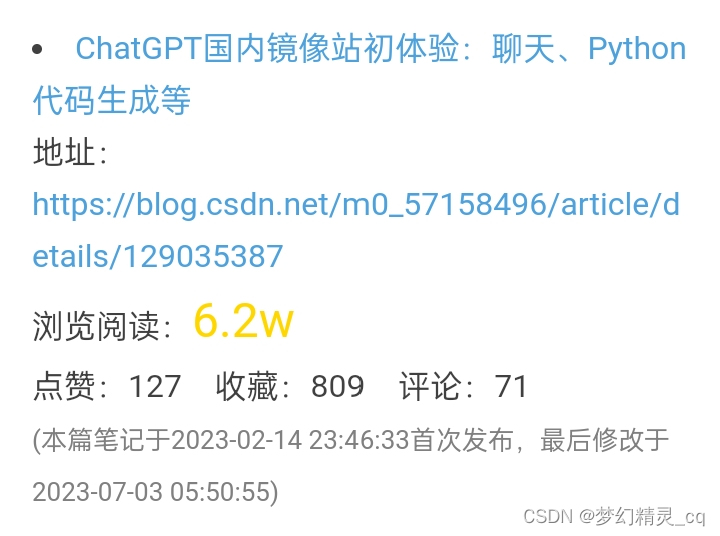英文分词(不用类似re等工具)
不用类似re等工具,将输入英文文本,拆分成一个个有意义的单词。
(笔记模板由python脚本于2024年01月15日 23:34:05创建,本篇笔记适合会基础编程,熟悉python字符串的coder翻阅)
-
Python 官网:https://www.python.org/
-
Free:大咖免费“圣经”教程《 python 完全自学教程》,不仅仅是基础那么简单……
地址:https://lqpybook.readthedocs.io/
??自学并不是什么神秘的东西,一个人一辈子自学的时间总是比在学校学习的时间长,没有老师的时候总是比有老师的时候多。
????????????—— 华罗庚
- My CSDN主页、My HOT博、My Python 学习个人备忘录
- 好文力荐、 老齐教室

本文质量分:
本文地址: https://blog.csdn.net/m0_57158496/article/details/135613713
CSDN质量分查询入口:http://www.csdn.net/qc
- ◆?英文分词
- 1、念想萌芽
- 2、算法解析
- 2.1 去除非字母字符
- 2.2 统计词频
- 2. 分词
- 3、完整源码(Python)
◆?英文分词
1、念想萌芽
??今天在 c s d n csdn csdn看到 j i e b a jieba jieba,脑中居然浮现出一个想法:“我可不可以撰写一段代码,实现 j i e b a jieba jieba一样的分词效果”。于是,我就开始了尝试……
2、算法解析
??解析
-
6 k + 6k+ 6k+
字符的试码文本英 文 美 文 . t x t 英文美文.txt 英文美文.txt

-
实现效果截屏图片
?
分 词 列 表 分词列表 分词列表

?
词 频 统 计 词频统计 词频统计

中间部分略

2.1 去除非字母字符
??描述
代码运行效果截屏图片
Python代码
def _isletter(self):
''' 剔除非字母字符 '''
lowers = ''.join(chr(i) for i in range(ord('a'), ord('z')+1)) # 生成26个小写字母字符串。
letters = tuple(lowers+lowers.upper())
#input(letters) # 校验字母列表。
words = [i if i in letters else ' ' for i in self.words] # 把非字母替换成英文空格字符。
return ''.join(words)
2.2 统计词频
??描述
代码运行效果截屏图片
Python代码
def _count(self, words):
''' 统计词频 '''
words = [(i, words.count(i)) for i in set(words)] # 列表解析式统计词频。
words.sort(key=lambda x: x[0]) # 按单词排序。
words.sort(key=lambda x: x[-1], reverse=True) # 按词频排逆序。
return words
2. 分词
??描述
代码运行效果截屏图片
Python代码
def split(self):
''' 分词 '''
nowords = ('I', 'me', 'my', 'main', 'you', 'your', 'hers', 'she', 'her', 'hers', 'he', 'his', 'him', 'we', 'our', 'ours', 'they', 'their', 'them', 'its', 'it', 'a', 'an', 'm', 's', 'd', 'did', 'do', 'doing', 'does', 'done', 'can', 'would', 'am', 'is', 'was', 'are', 'were', 'be', 'have', 'has', 'often', 'always', 'to', 'too', 'very', 'many', 'any', 'in', 'on', 'with', 'at', 'of', 'up', 'down', 'go', 'goes', 'went', 'for', 'about', 'now', 'if', 'but', 're','from', 'the', 'there', 'this', 'that', 'than', 'when', 'what', 'where', 'who', 'why', 'so', 'as', 'yes', 'no', 'not', 'jion', 'or', 'and', 'by', 'but')
nowords = list(nowords) + [i.title() for i in nowords]
#input(nowords) # 校验无效单词列表。
words = [i for i in self._isletter().split() if i and i not in nowords] # 去除空格和无效单词。
print(words) # 打印分词列表。
return self._count(words)
3、完整源码(Python)
(源码较长,点此跳过源码)
#!/sur/bin/nve python
# coding: utf-8
'''
英文分词
'''
class EnSplit:
def __init__(self, text):
self.words = text
def _isletter(self):
''' 剔除非字母字符 '''
lowers = ''.join(chr(i) for i in range(ord('a'), ord('z')+1)) # 生成26个小写字母字符串。
letters = tuple(lowers+lowers.upper())
#input(letters) # 校验字母列表。
words = [i if i in letters else ' ' for i in self.words] # 把非字母替换成英文空格字符。
return ''.join(words)
def _count(self, words):
''' 统计词频 '''
words = [(i, words.count(i)) for i in set(words)] # 列表解析式统计词频。
words.sort(key=lambda x: x[0]) # 按单词排序。
words.sort(key=lambda x: x[-1], reverse=True) # 按词频排逆序。
return words
def split(self):
''' 分词 '''
nowords = ('I', 'me', 'my', 'main', 'you', 'your', 'hers', 'she', 'her', 'hers', 'he', 'his', 'him', 'we', 'our', 'ours', 'they', 'their', 'them', 'its', 'it', 'a', 'an', 'm', 's', 'd', 'did', 'do', 'doing', 'does', 'done', 'can', 'would', 'am', 'is', 'was', 'are', 'were', 'be', 'have', 'has', 'often', 'always', 'to', 'too', 'very', 'many', 'any', 'in', 'on', 'with', 'at', 'of', 'up', 'down', 'go', 'goes', 'went', 'for', 'about', 'now', 'if', 'but', 're','from', 'the', 'there', 'this', 'that', 'than', 'when', 'what', 'where', 'who', 'why', 'so', 'as', 'yes', 'no', 'not', 'jion', 'or', 'and', 'by', 'but')
nowords = list(nowords) + [i.title() for i in nowords]
#input(nowords) # 校验无效单词列表。
words = [i for i in self._isletter().split() if i and i not in nowords] # 去除空格和无效单词。
print(words) # 打印分词列表。
return self._count(words)
if __name__ == '__main__':
text = '''
I'm a old man. I love Python.
我是一个老男人,我爱Python。
'''
text = open('/sdcard/Documents/英文美文.txt').read()
en = EnSplit(text)
print('\n'.join([f"{i[0]}: {i[-1]}" for i in en.split()]))
上一篇:? 正则表达式中的“回引用(回溯)”($Python$正则表达式中的“回引用(回溯)”——分组别名引用与序号引用的差异及正则表达式中的“P”关键字详情)
下一篇:?
我的HOT博:
??本次共计收集289篇博文笔记信息,总阅读量44.72w。数据采集于2023年12月11日 23:07:13,用时5分11.8秒。阅读量不小于4.0k的有17篇。
- ChatGPT国内镜像站初体验:聊天、Python代码生成等
地址:https://blog.csdn.net/m0_57158496/article/details/129035387
浏览阅读:6.2w
点赞:127?收藏:809?评论:71
(本篇笔记于2023-02-14 23:46:33首次发布,最后修改于2023-07-03 05:50:55)
? - 让QQ群昵称色变的神奇代码
地址:https://blog.csdn.net/m0_57158496/article/details/122566500
浏览阅读:5.8w
点赞:24?收藏:86?评论:17
(本篇笔记于2022-01-18 19:15:08首次发布,最后修改于2022-01-20 07:56:47)
? - Python列表(list)反序(降序)的7种实现方式
地址:https://blog.csdn.net/m0_57158496/article/details/128271700
浏览阅读:9.9k
点赞:5?收藏:30?评论:8
(本篇笔记于2022-12-11 23:54:15首次发布,最后修改于2023-03-20 18:13:55)
? - pandas 数据类型之 DataFrame
地址:https://blog.csdn.net/m0_57158496/article/details/124525814
浏览阅读:9.4k
点赞:7?收藏:34?
摘要:pandas 数据类型之 DataFrame_panda dataframe。
(本篇笔记于2022-05-01 13:20:17首次发布,最后修改于2022-05-08 08:46:13)
? - 个人信息提取(字符串)
地址:https://blog.csdn.net/m0_57158496/article/details/124244618
浏览阅读:7.7k
摘要:个人信息提取(字符串)_python个人信息提取。
(本篇笔记于2022-04-18 11:07:12首次发布,最后修改于2022-04-20 13:17:54)
? - Python字符串居中显示
地址:https://blog.csdn.net/m0_57158496/article/details/122163023
浏览阅读:7.2k
评论:1
? - 罗马数字转换器|罗马数字生成器
地址:https://blog.csdn.net/m0_57158496/article/details/122592047
浏览阅读:7.2k
(本篇笔记于2022-01-19 23:26:42首次发布,最后修改于2022-01-21 18:37:46)
? - 斐波那契数列的递归实现和for实现
地址:https://blog.csdn.net/m0_57158496/article/details/122355295
浏览阅读:5.6k
点赞:4?收藏:2?评论:8
? - 回车符、换行符和回车换行符
地址:https://blog.csdn.net/m0_57158496/article/details/123109488
浏览阅读:5.5k
点赞:2?收藏:3?
摘要:回车符、换行符和回车换行符_命令行回车符。
(本篇笔记于2022-02-24 13:10:02首次发布,最后修改于2022-02-25 20:07:40)
? - python清屏
地址:https://blog.csdn.net/m0_57158496/article/details/120762101
浏览阅读:5.3k
? - 练习:字符串统计(坑:f‘string‘报错)
地址:https://blog.csdn.net/m0_57158496/article/details/121723096
浏览阅读:5.1k
? - 练习:尼姆游戏(聪明版/傻瓜式?人机对战)
地址:https://blog.csdn.net/m0_57158496/article/details/121645399
浏览阅读:5.1k
点赞:14?收藏:44?
? - 我的 Python.color() (Python 色彩打印控制)
地址:https://blog.csdn.net/m0_57158496/article/details/123194259
浏览阅读:4.6k
点赞:2?收藏:8?
摘要:我的 Python.color() (Python 色彩打印控制)_python color。
(本篇笔记于2022-02-28 22:46:21首次发布,最后修改于2022-03-03 10:30:03)
? - 练习:生成100个随机正整数
地址:https://blog.csdn.net/m0_57158496/article/details/122558220
浏览阅读:4.6k
(本篇笔记于2022-01-18 13:31:36首次发布,最后修改于2022-01-20 07:58:12)
? - 密码强度检测器
地址:https://blog.csdn.net/m0_57158496/article/details/121739694
浏览阅读:4.4k
(本篇笔记于2021-12-06 09:08:25首次发布,最后修改于2022-11-27 09:39:39)
? - 罗马数字转换器(用罗马数字构造元素的值取模实现)
地址:https://blog.csdn.net/m0_57158496/article/details/122608526
浏览阅读:4.2k
(本篇笔记于2022-01-20 19:38:12首次发布,最后修改于2022-01-21 18:32:02)
? - 练习:班里有人和我同生日难吗?(概率probability、蒙特卡洛随机模拟法)
地址:https://blog.csdn.net/m0_57158496/article/details/124424935
浏览阅读:4.0k
摘要:班里有人和我同生日难吗?(概率probability、蒙特卡洛随机模拟法)_生日模拟问题,计算频率,并画出随着试验次数n的增大,频率和理论概率的 关系图。
(本篇笔记于2022-04-26 12:46:25首次发布,最后修改于2022-04-27 21:22:07)
截屏图片

??(此文涉及ChatPT,曾被csdn多次下架,前几日又因新发笔记被误杀而落马。躺“未过审”还不如回收站,回收站还不如永久不见。😪值此年底清扫,果断移除。留此截图,以识“曾经”。2023-12-31)

精品文章:
- 好文力荐:齐伟书稿 《python 完全自学教程》 Free连载(已完稿并集结成书,还有PDF版本百度网盘永久分享,点击跳转免费🆓下载。)
- OPP三大特性:封装中的property
- 通过内置对象理解python'
- 正则表达式
- python中“*”的作用
- Python 完全自学手册
- 海象运算符
- Python中的 `!=`与`is not`不同
- 学习编程的正确方法
来源:老齐教室
◆ Python 入门指南【Python 3.6.3】
好文力荐:
- 全栈领域优质创作者——[寒佬](还是国内某高校学生)博文“非技术文—关于英语和如何正确的提问”,“英语”和“会提问”是编程学习的两大利器。
- 【8大编程语言的适用领域】先别着急选语言学编程,先看它们能干嘛
- 靠谱程序员的好习惯
- 大佬帅地的优质好文“函数功能、结束条件、函数等价式”三大要素让您认清递归
CSDN实用技巧博文:
本文来自互联网用户投稿,该文观点仅代表作者本人,不代表本站立场。本站仅提供信息存储空间服务,不拥有所有权,不承担相关法律责任。 如若内容造成侵权/违法违规/事实不符,请联系我的编程经验分享网邮箱:chenni525@qq.com进行投诉反馈,一经查实,立即删除!
- Python教程
- 深入理解 MySQL 中的 HAVING 关键字和聚合函数
- Qt之QChar编码(1)
- MyBatis入门基础篇
- 用Python脚本实现FFmpeg批量转换
- 机器视觉是什么?能做什么?有什么优点?
- 《向量数据库指南》——Milvus Cloud支持上万个 Collection、新增 Accesslog 功能……
- React16源码: Why16, 研究源码的意义, 源码目录核心结构分析
- Python求解特殊回文数
- 安装Neo4j
- 嵌入式培训机构四个月实训课程笔记(完整版)-Linux系统编程第五天-Linux消息共享内存练习题(物联技术666)
- 京东数据分析工具(鲸参谋):如何判断红蓝海市场及行业前景
- 最全SOLIDWORKS购买指南,告诉你如何快速购买
- 用java实现:将数据的每个字节按位翻转,但字节的顺序不变
- Nginx问题分析